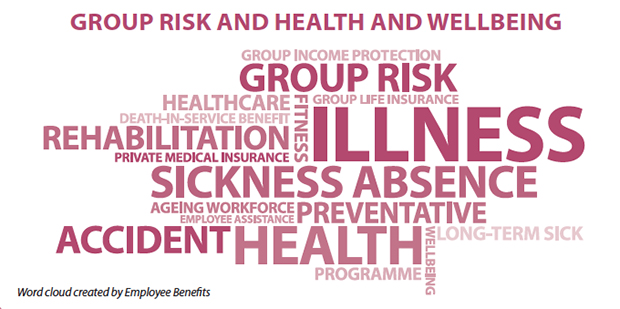Group risk benefits are a key piece of an employer’s health and wellbeing package. But how should they be promoted to staff?

If you read nothing else, read this…
- Group risk benefits are designed to support staff and employers when workers are absent due to an injury or critical illness.
- Employers could do more to highlight the importance of group risk benefits and promote these alongside other healthcare benefits.
- An ageing workforce increases the need for more awareness of group risk products.
Group risk benefits are considered to be a cornerstone of an employer’s benefits package and help to support employees when they are in a dire situation, usually unable to work due to a serious injury or critical illness. Ideally, they should sit well alongside health and wellbeing benefits, but many employees may be unaware of the role they play. Rachel Lock, HR director at TSB, says: “Group risk is only effective when integrated with a wider health and wellbeing programme, and when staff are empowered to choose what is appropriate for them.”
What is the purpose of group risk benefits?
Group risk benefits include group income protection, life insurance and critical illness cover. The options available and how these are offered to staff, however, have changed over time. John Dean, director at Punter Southall Health and Protection (PSHPC), says: “In the 1970s and 1980s, [life insurance] was part of final salary [defined benefit] pension schemes and income protection wasn’t really around.”
The number of the UK population covered by group risk schemes grew by 200,000 in 2014, according to the Swiss Re Group watch 2015 report, published in April 2015, highlighting that recognition of schemes’ advantages and popularity continues to improve.
Group risk and health and wellbeing
Employers should consider group risk benefits a vital part of workplace health and wellbeing, but employees need more information about what the benefits cover and how these can support them. Tania Pierce-Jones, senior relationships manager at healthcare provider Wellbeing People, says: “I would imagine that 70% of employees don’t know what group risk entails. The communication around it really needs to improve.”
When health and wellbeing and group risk work well together, their integration can actually decrease the need for group risk benefits, she adds. “The process would work a lot better if people were aware of its stages rather than just utilising group risk benefits once an employee has already gone off sick, and employers tried to prevent absences in the first place.”
Looking at both group risk and health and wellbeing in tandem can provide employers with a comprehensive health provision to counter any eventuality. John Matthews, senior consultant at Mercer, says: “It’s about preventative care and balancing where healthcare budget is spent, because employers need to provide support to those who might not make a group risk claim. A decent health and wellbeing strategy really needs to embrace something that will help ill employees to be supported in their recovery.”
Important piece of healthcare puzzle
Some 77% of employees cannot afford to maintain a living on statutory sick pay, according to research by PMI Health Group published in September 2014. This demonstrates the necessity of group risk benefits in supporting employees and their organisations. Matthews says: “Group risk gets overlooked and disconnected from overall health and wellbeing. We’re faced with an ageing working population, which will bring more chronic illnesses and presenteeism. It’s this kind of situation where group risk acts as a vital backstop.”
This is reinforced by research published by Towers Watson in October 2014, which highlights how employers face cost increases in their employee insurance premiums as the age of the workforce continues to rise. It also reflects the necessity for employers to do more to highlight the purpose of group risk benefits and how these play a key role in a health and wellbeing strategy.
Ensuring group risk benefits are promoted alongside healthcare and wellbeing programmes will help to boost employees’ understanding of the schemes. Nick Skipper, head of major accounts at Willis Employee Benefits, says: “There’s always more that can be done to communicate what group risk means to different sections of a workforce.”
And with three-quarters (75%) of employers not being able to identify or manage known employee health risks, according to Aon’s annual Benefits and trends survey, published in October 2014, it’s clearly important for employers to do more to improve their own understanding of group risk, as well as employees’ understanding. Ron Wheatcroft, technical manager at Swiss Re, says: “There is a powerful bond between employer and employee to make staff understand the importance of group risk.”
Wheatcroft believes the most straightforward answer to increasing employee awareness around what group risk entails is to shout it from the rooftops. ”Employees have very little idea what their employer actually provides to them,” he says. “Group risk is a really positive statement that employers can make to staff.”
Willis Employee Benefits’ Skipper adds: “Group risk should be seen as something that forms an integral part of heath and wellbeing. It needs to be tailored to individual organisations’ and employees’ risk profiles as an end-to-end solution.
“Group risk and heath and wellbeing need to be a little more joined up to show how one feeds into the other.”
Katharine Moxham: Healthcare needs group risk to be effective

Benefits in silos are well and truly gone, and group risk is no exception to this.
Over recent years, group risk providers have worked hard to deliver value beyond the payment of claims, and to offer support services that complement their offering and health and wellbeing strategies.
Today’s group risk proposition focuses as much on mitigating risk and offering support as on paying claims.
As well as paying £3.45m a day in claims in 2014, group risk providers helped more than 1,500 employees back to work through active interventions, thus avoiding a long-term absence.
Death or disability has a life-changing impact on staff and their families irrespective of age or role. Crucially, group risk products offer support, such as employee assistance programmes (EAPs), HR and legal advice, online health assessments, mental health first-aid training and fast-track access to counselling and physiotherapy.
These benefits are extremely effective in keeping staff in the workplace, giving them the help they need to make life changes and supporting them back to work. Their services can be used every single day, even if a claim is never made, and can drive engagement and release money to spend elsewhere.
Increasingly, employers are recognising the value to their business of having a healthy and resilient workforce.
Moving forward, employers with group risk insurance protection will not only have insured their benefit promise, but they will be well placed to support prevention as well as cure.
Katharine Moxham is spokesperson for industry body Group Risk Development (Grid)
Case study: NHBC uses group risk benefits to prepare for the future

The National House Building Council (NHBC) aims to take care of its 1,200 staff for the long term through its provision of group risk and healthcare benefits.
Employees receive group life insurance if they are part of the homeowners insurance firm’s group personal pension (GPP) scheme. The insurance policy consists of four times the employee’s annual salary to be passed onto dependants. Dependants of employees who are not a member of the pension scheme receive one year’s worth of salary. The benefit is also used as an incentive for employees not to opt out of the pension scheme.
John Attley, engagement manager at NHBC, says: “We want to look after the whole person in terms of wellbeing and group risk. We have built a landscape of benefits to help employees, even for what the future holds.”
NHBC’s healthcare provision includes an employee assistance programme (EAP), blood pressure checks, seasonal flu vaccinations, eye tests, private medical insurance (PMI), pilates classes, healthy-eating options in the head-office restaurant, gym membership offered via salary sacrifice and online health assessments that provide tailored feedback for all staff.
Attley adds: “Critical to success is to give all staff as many options as we can regardless of geography. For example, we can run a flu jab clinic in our head office, but give remote staff, about 60% of our colleagues, the option of a voucher they can redeem locally.”
With its average length of service for staff standing at nine years, NHBC recognises the need to provide health, wellbeing and group risk benefits for the long term.
Attley says: “When you combine group life insurance with other benefits and communication, it becomes part of the overall engagement piece.
”It is absolutely important for employees to see how healthcare and wellbeing aligns with group risk with a single, coherent campaign package.
”Inevitably, staff are going to be working longer, and the next generation will see the effects of that trickle through even more. That’s when group risk comes into its own.”
